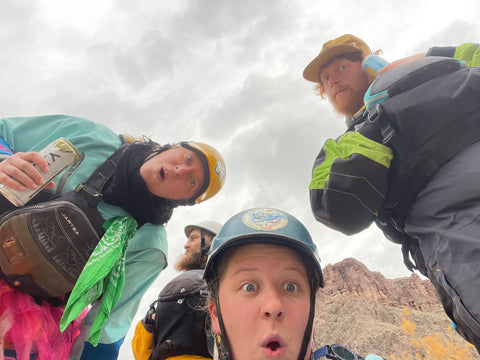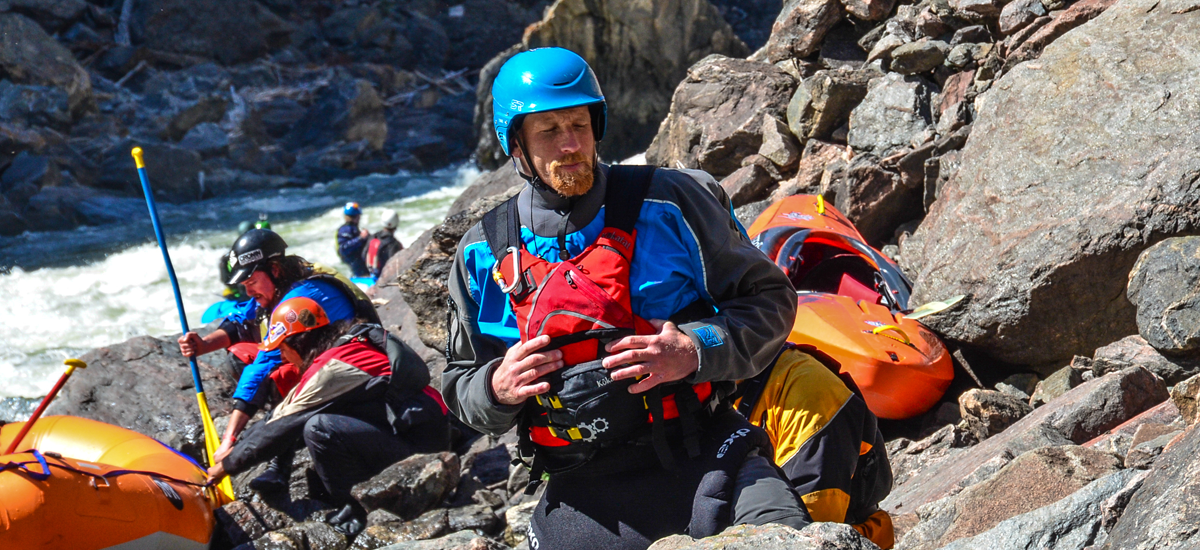Here at CKS, we are proud to stock all of the brands we carry. That being said, each brand has its comparative advantages and disadvantages. We carry four dry wear brands: Kokatat, NRS, Immersion Research, and Level Six. All brands manufacture their own proprietary waterproofing materials and Kokatat and NRS make GORE-TEX Pro garments as well.
Drysuits have revolutionized whitewater boating, making it possible for enthusiasts to extend their paddling season and explore even the coldest and most remote waters. These suits keep the wearer warm and dry in harsh conditions, allowing them to focus on their paddling and enjoy the experience.
What are the real differences between GORE-TEX and proprietary waterproofing materials?

Who doesn't like to stay dry?
GORE-TEX
GORE-TEX was developed in the '70s and has been a staple in outdoor gear for over 50 years thanks to its superior breathability, durability and waterproofness. It is the top name in tech fabrics that has stood the test of time.
W.L. Gore Company is very selective in which brands they will allow to use their patented fabrics, as to not flood the market with products of sub-quality manufacturing that is not in line with GORE-TEX’s superior breathability performance. In paddlesports, you will currently only find GORE-TEX in Kokatat and NRS' dry suits, dry pants, dry tops, and other paddling outerwear. But does that mean it is drier? Not necessarily, continue reading and make the call for yourself!
Dry suits are typically built with three distinct layer:, a protective outer shell, inner membrane and protective knit liner fabric. As whitewater boaters we are especially hard on our gear which calls for an extra-thick outer layer for durability--our dry suits are not going to be nearly as breathable as your favorite Gore-Tex ski jacket!
Some of the Kokatat and NRS GORE-TEX selection.
Polyester + Nylon
Polyester fabric is hydrophobic, meaning it repels water and will not generally "wet out" on the wearer. This makes it a good choice for long trips or those who get cold easily. However, it is weaker than other materials and may be prone to rips and tears, especially if the wearer is bushwhacking or otherwise rough on their suit. Our recommended polyester suit would be the Immersion Research Men's 7 Figure Dry Suit or the Immersion Research Women's Aphrodite Dry Suit!
Nylon, on the other hand, is highly durable and resistant to damage, making it a good choice for those who are rough on their gear. However, it is heavier and more hydrophilic than polyester, meaning it may attract water and feel heavier over time. Check out the highly rated Nylon based suits like the Level Six Men's Emperor Dry Suit!

See? Both Gore (left) and Hydrus (right) are pretty dang waterproof.
Normally built with 3 to 4 layers, a tough, abrasion-resistant outer layer protects the suit from damage from rocks and branches, a waterproof and breathable membrane that prevents the water from getting into the suit while allowing some sweat and moisture to escape, a hydrophobic layer the repels water to keep the fabric from getting "wet down," and a soft inner layer that wicks moisture away from the skin.
Some of the Kokatat Hydrus 3L selection.
THE VERDICT
"Drysuits are an essential piece of gear for cold water boating." - Jonny Ortiz
In summary, the main differences between IR Drysuits, NRS Gore-Tex Pro, Level Six, and Kokatat Gore-Tex and Hydrus drysuits lie in the specific materials and technologies used in their construction. Subtle differences in seam tape location, zipper location and care will all vary by vendor. All of these drysuits are designed for extreme conditions and offer added durability, and they will all do a great job at keeping you dry in whitewater!

All modern drysuit materials are suitable for most rafters.
LIFETIME WARRANTIES FOR ALL
Kokatat, NRS, Immersion Research and Level Six all guarantee their dry wear for life, so you can be sure that whether you choose proprietary waterproofing or GORE-TEX, you’re making a good investment in gear that will last!
Originally posted September 4, 2020.
Updated March 2, 2023.

